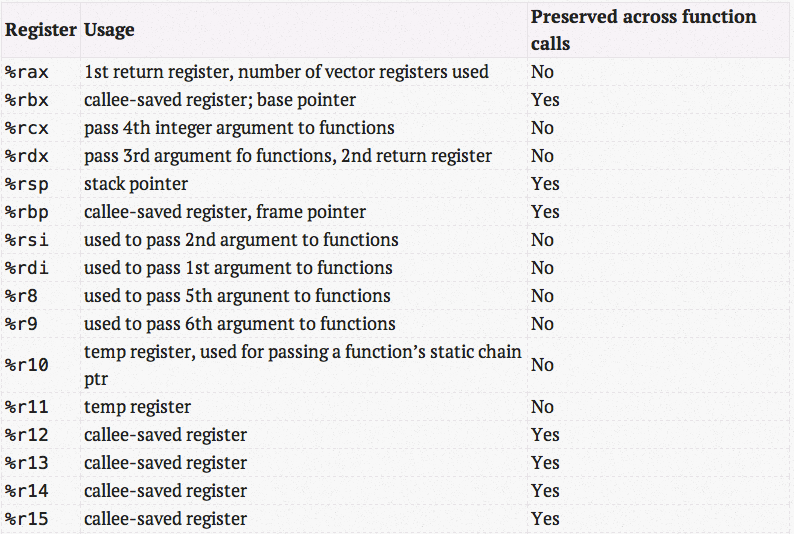64位汇编参数传递
64位汇编
当参数少于7个时, 参数从左到右放入寄存器: rdi, rsi, rdx, rcx, r8, r9。
当参数为7个以上时, 前 6 个与前面一样, 但后面的依次从 “右向左” 放入栈中,即和32位汇编一样。
参数个数大于 7 个的时候
H(a, b, c, d, e, f, g, h);
a->%rdi, b->%rsi, c->%rdx, d->%rcx, e->%r8, f->%r9
h->8(%esp)
g->(%esp)
call H
Linux (and Windows) x86-64 calling conventionhas the first few arguments noton the stack, but in registers instead
See http://www.x86-64.org/documentation/abi.pdf (page 20)
Specifically:
If the class is MEMORY, pass the argument on the stack.
If the class is INTEGER, the next available register of the sequence %rdi, %rsi, %rdx, %rcx, %r8 and %r9 is used.
If the class is SSE, the next available vector register is used, the registers are taken in the order from %xmm0 to %xmm7.
If the class is SSEUP, the eightbyte is passed in the next available eightbyte chunk of the last used vector register.
If the class is X87, X87UP or COMPLEX_X87, it is passed in memory.
The INTEGERclass is anything that will fit in a general purpose register
【x86_64 Assembler Calling Convention】
1、x86_64 registers

2、x86_64寄存器特性表

3、特性要点:
1)常用寄存器有16个,分为x86通用寄存器以及r8-r15寄存器。
2)通用寄存器中,函数执行前后必须保持原始的寄存器有3个:是rbx、rbp、rsp。rx寄存器中,最后4个必须保持原值:r12、r13、r14、r15。
保持原值的意义是为了让当前函数有可信任的寄存器,减小在函数调用过程中的保存&恢复操作。除了rbp、rsp用于特定用途外,其余5个寄存器可随意使用。
3)通用寄存器中,不必假设保存值可随意使用的寄存器有5个:是rax、rcx、rdx、rdi、rsi。其中rax用于第一个返回寄存器(当
然也可以用于其它用途),rdx用于第二个返回寄存器(在调用函数时也用于第三个参数寄存器)。rcx用于第四个参数。rdi用于第一个参数。rsi用于
第二个函数参数。
4)r8、r9分配用于第5、第6个参数。



